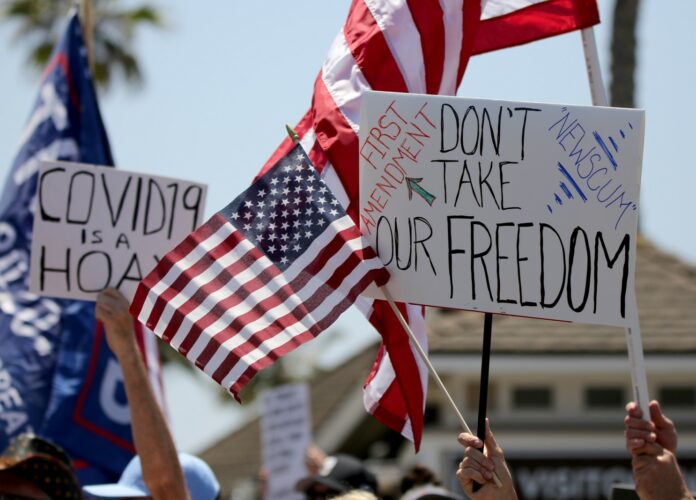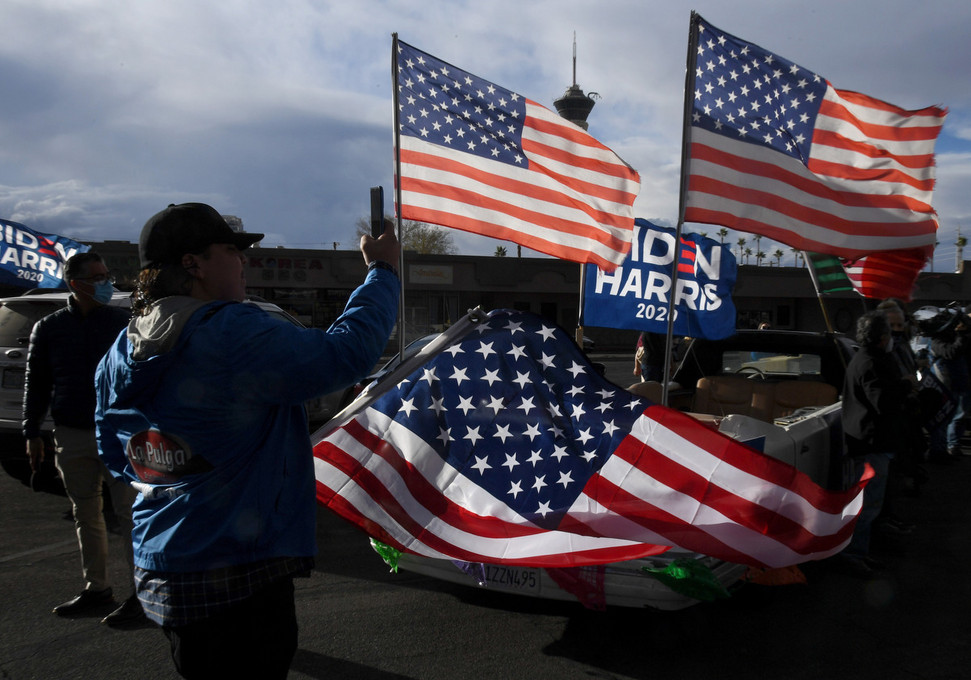By Katya Mavrelli,
Almost one month after the vivid November 2020 U.S. Elections, there is a sight to behold in the U.S.: national flags appear on porches, on rooftops and lawns across the county. As if waking up from their slumber, Americans are once more displaying their patriotism and faith in their country by welcoming their flags back in their lives. And though this might be a relatively small change to observe, it symbolizes the rebirth of democracy.
The President-elect’s victory speech has been embraced and welcomed by a strong majority of American voters. This does not necessarily mean they are all blindly following the Democrat political rhetoric, nor that they are born-and-raised Biden fanatics; they are simply celebrating the movement towards democracy once more. And the more flags are being hung around, the more one realizes this represents something bigger: a spontaneous reclaim of a symbol that during the Trump years had come to represent only one side.
The politicization of the white stars on a blue canopy and the horizontal red-white stripes predates the Trump administration. In the Vietnam era, military associations made the flag a fraught symbol, associated with something distant and aggressive. In the Reagan years, the flag came to represent an exception to free speech, with left-wing flag-burning protesters sparking Republican efforts to amend the Constitution. But Trump, for all his lack of talent in delicate political maneuvering and his adoption of swift and decisive acts, has managed to take the divide between the left and the right even further. Due to his theatrical political talent and his penchant for striking deep partisan rifts, he has deeply divided the country, reopening the already existing wounds of political disunity. The U.S. had been a disharmonized nation, but Trump accentuated the political divide and turned the United States into a not so united place.
Four years ago, the U.S. flag was recast as an extension of the “Make America Great Again” hat; the two co-existed and represented the patriotic sentiments that Trump so powerfully wanted to restore and protect by all means. Yet, the November election serves as the rebirth not only of the Democrat party, but also of the nation. The flag once more represents a united nation, not just a section of it, and conveys a freshly crafted perception of unity.
Under Trump and the “America First” rhetoric, the American flag, which was already an inherently problematic symbol of nationalism, had become further twisted thanks to its embrace by fascist fringes within the U.S. political landscape. But as Joe Biden and Kamala Harris walked on that stage and addressed the deeply wounded U.S. public, the American flag was reclaimed by many of the same people who had long avoided it during the last four years, given that Trump managed to shift the meaning of the flag itself. As any national symbol, it can be interpreted as a dyad: it can be something inclusive, representing a diverse group of people who unite behind a set of common principles, i.e. freedom, democracy, openness and respect towards the law. At the same time, however, it can be exclusive, a symbol of nationalism; the “us” in opposition to the less worthy or virtuous “them”.
As Trump spent the last four years in a warlike stance, ready to pounce on anything that resembled an opportunity and preparing to take out anyone slightly mirroring an enemy, the message of “it’s us against them” reverberated across the domestic political sphere. A symbol was turned into a weapon, sharpened at any opportunity and used against anything perceived as a threat. And this is how the flag came to represent Trumpism: the oversized Trump-Pence flags that unfurled at beach homes in Florida and Jersey Shore were a way for Trump supporters to rub their political leanings in their opponents’ faces. The confederate flag, a symbol of racial division, soon made its appearance on Trump rallies along with the typical protagonists, the MAGA hat and the altered flags with Trump on them. During the summer, the newcomer in the Trump fan club merchandise also made a grand entrance to the domestic political scene: the ‘blue liver matter’ flag, a black-and-white version of the American flag with one blue stripe, created in response to anti-police protests in 2014, started waving next to the traditional one.
And the more Trump boldly dominated politics, the more the flag became emblematic of a larger narrative. For those anti-Trump voters, it represented their wounded democracy, fragmented and under threat, that was walking away from their hands, distancing itself in the midst of a Trump cyclone. More commonly, people shied away from what they feared would be an association with the “wrong side”. In liberal enclaves, entirely new yard signs cropped up, out of need, acting as alternatives to the flag and allowing people to proclaim their belonging to a different America. Yard signs advocating for beliefs about equality and human rights, access to clean water and racial justice are among the most common replacements of the traditional flag. The more liberals and progressives detached from the flag, the more Trump and his allies embraced it, which made it harder and harder to see the flag in a nuanced way.
This representation isn not bound to evaporate as soon as American’s fiercest partisan departs. There will always be some Trumpism out there, waiting for its opportunity to pounce. Yet the Biden-Harris duo might spell out a new era for the U.S. and, consequently, for the American flag. As something that symbolizes not only the history, but also the values that Americans hold dear, its redefinition will be somewhat of a challenging job. Surely it depends on the domestic and foreign approach the Biden administration will adopt and the extent to which the initiatives will be dutiful or not.
But deep down, the flag might also represent another democracy, a more fledgling one, which like a phoenix is just starting to rise from the ashes of the Trump years. The revivification out of the liberal and inclusive pre-Trump sentiments is something that Biden will have to cultivate and ensure, if we are still to talk about the United States of America, rather than some fragmented, divided and shattered nation.
References
The New York Times, What does the MAGA hat mean now? Available here.
The New Yorker, The changing meaning of the American flag under Trump. Available here.
The Guardian, I grew up with the American flag, now the stars and stripes seem hostile. Available here.






